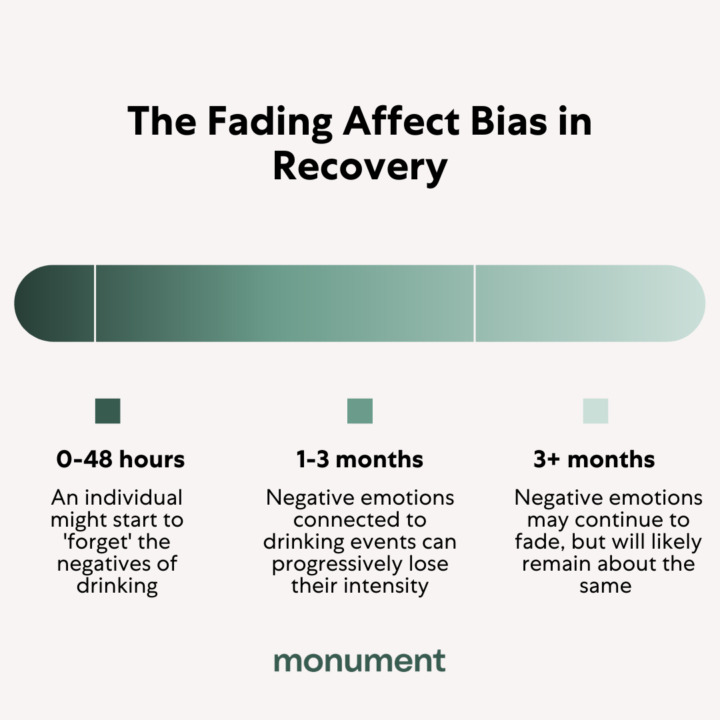What is Fading Affect Bias?
Fading affect bias (FAB) is a psychological phenomenon that refers to the tendency for unpleasant emotions to fade more quickly than pleasant emotions.¹ Some studies suggest this can be a healthy coping skill that increases positivity in people’s lives. However, in some cases it can reinforce maladaptive behaviors. For example, if the negative emotions associated with unhealthy alcohol use fade more quickly from our memory, it can increase the likelihood of someone drinking heavily again in the future.¹
FAB Explained: Why Does it Happen?
Recalling memories of any kind, good or bad, typically triggers an emotional response. Studies show that we typically feel the same emotions when remembering an event that we did when it was actually happening. But these emotions fade in intensity over time.² One reason this occurs is because holding onto negative feelings places an unnecessary burden on the cognitive and biological systems in our bodies. It’s like a self-protective measure; our brains unconsciously “let go” of the intensity of negative emotions, so that we can preserve our brain space and energy.
How Does the Fading Affect Bias Impact Alcohol Recovery?
The fading affect bias can apply to many areas of our lives. For example, many of us have the tendency to suddenly remember all the good things after we break up with someone. The same can be true for how people think about alcohol when they decide to stop drinking. After a period of sobriety, it’s common for people to miss many of the things they associate with drinking, like the temporary relaxation or going to events that involve alcohol. As a result, it’s easier for those positive feelings to overshadow the negative implications of drinking, such as hangovers, health risks, and embarrassments.
Being aware of the fading affect bias can help us prepare for this phenomenon. If you find yourself longing for the “good old days”, you can compassionately keep in mind all of the ways alcohol was negatively affecting your life and the reasons you decided to stop drinking. A large part of the recovery process is learning to hold conflicting emotions; we can acknowledge that alcohol served a purpose in our lives at some point, while also recognizing it has become unhealthy and isn’t serving us anymore.
FAB Timeline

People can begin feeling the effects of FAB within one day of discontinuing alcohol use and it can persist for months.³ The first three months of sobriety is when someone is most likely to experience the fading affect bias and look back on drinking memories fondly. This is an important time to stay engaged in your sobriety toolkit in order to avoid a relapse. After these three months, FAB is less likely to play a role in someone’s recovery journey. That said, everyone’s alcohol recovery timeline is different.
Arming yourself with knowledge and information can also lessen the FAB phenomenon. As you learn about how alcohol really impacts the body and the health consequences associated, the negatives of drinking start to stand out more. As a result, many people report that if they do have a lapse and decide to drink again, it wasn’t as fun or carefree as it may have been in the past.
How to Overcome Fading Affect Bias
Just the act of learning about the fading affect bias is a huge step in itself. In addition, there are many healthy coping skills that can help you combat the risks of FAB.
Stay Connected
The power of connection and community in recovery can’t be underestimated. The more you stay engaged with sobriety communities and tools, the less likely you are to lose sight of your goals and return to drinking. Support groups can provide a safe and supportive environment for people to come together and have real conversations about both the joys and the challenges of sobriety. You can also join Facebook groups, listen to podcasts, or read books about recovery.
Support Group: Transforming challenge into opportunity
Define Your “Why”
It’s helpful to write down why you want to stop drinking in the first place, and create visual reminders of this in your environment. You can keep this list on your phone or put post-it notes of your “why” up on your bathroom mirror. Another tip is to create a pros and cons list. Write down the pros of sobriety, and the cons of drinking, and keep this in a place you can look at whenever you need a reminder.
Find New Joys
Learning new things is an excellent way to engage our minds and replace a drinking habit. Pottery, knitting, yoga, running, glass blowing, painting, learning a new language… the possibilities are endless. Here are a few fun alcohol-free activities to get you started.
Recovery isn’t just about abstaining from alcohol. It’s also about changing our patterns and behaviors, which leads to endless possibilities. Sobriety often feels uncomfortable at first, but remember it’s also an opportunity for expansion.

Staying Motivated with Monument
It’s perfectly normal to need extra support in order to stay motivated and engaged with your sobriety. Sobriety communities are a helpful way to establish a sense of connection and support. Monument has over 60 weekly therapist-moderated support groups. They also offer one-on-one therapy, and physician appointments to see if medication to stop drinking is appropriate for you. These tools can make a huge difference in maintaining long-term sobriety or moderation. You’re not alone.
Sources:
- Consciousness and Cognition. “The fading affect bias across alcohol consumption frequency for alcohol-related and non-alcohol-related events, https://www.sciencedirect.com/science/article/abs/pii/S1053810013001311.” Accessed Feb 22, 2023.
- Cognitive Psychology. “The Fading affect bias: But what the hell is it for?, https://www.niu.edu/jskowronski/publications/walkerskowronski2009.pdf.” Accessed Feb 22, 2023.
- Applied Cognitive Psychology. “The fading affect bias begins within 12 hours and persists for 3 months, https://onlinelibrary.wiley.com/doi/abs/10.1002/acp.1738.” Accessed Feb 22, 2023.